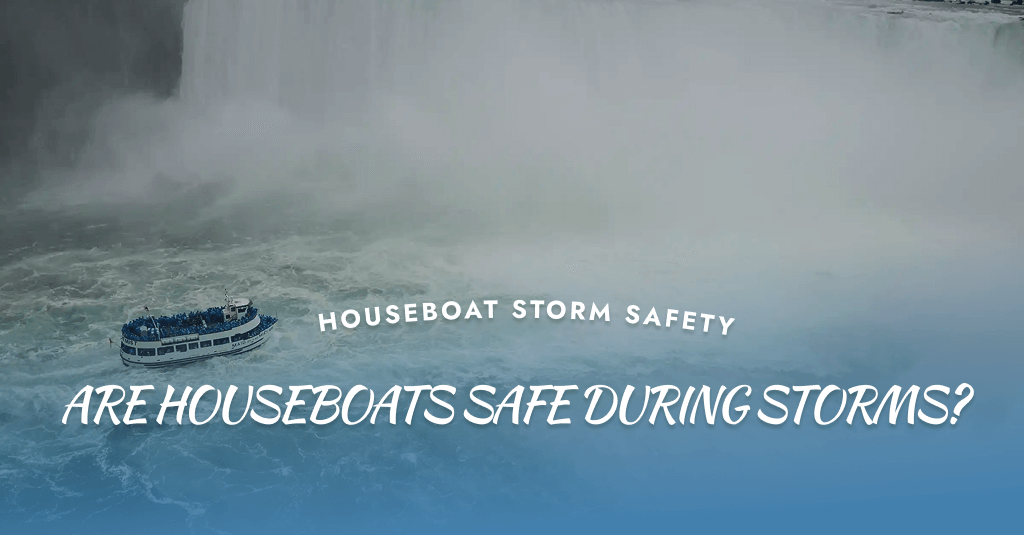
Houseboat Storm Safety: Are Houseboats Safe During Storms?
Houseboats offer an idyllic way to live on or escape to the water, combining freedom and natural beauty with the comforts of home. But when the skies turn dark and wind picks up, one critical question arises: Are houseboats safe during storms?
Weather is one of the most unpredictable forces affecting life on the water. Whether you’re a weekend boater or a full-time liveaboard, understanding houseboat storm safety is essential for protecting your vessel, passengers, and peace of mind.
This guide explores how storms impact houseboats, the risks involved, and proven tips to stay safe and prepared in severe weather. From lightning to hurricanes, we’ll walk you through everything you need to know.
How Safe Are Houseboats in Storm Conditions?
The safety of a houseboat during a storm largely depends on three factors:
-
Where the boat is located
-
How well it’s secured
-
The intensity of the storm
Unlike ocean-going vessels, most houseboats are designed for calm inland waters such as lakes, rivers, and protected bays. That means they’re not built to handle large ocean swells or long exposure to strong winds. However, many houseboats can withstand moderate storm conditions with the proper preparation.
The key to houseboat storm safety is planning, understanding local weather threats, and outfitting your boat with the right gear.
Understanding the Risks of Storms on Houseboats
While houseboats can be safe in many situations, certain storm-related hazards can become serious threats if ignored. Here are the most common storm dangers:
1. High Winds
Wind gusts over 30–40 mph can rock your boat, strain mooring lines, and push floating debris into your hull.
2. Lightning Strikes
Water is an excellent conductor of electricity, making lightning a real concern. Houseboats with metal components are especially vulnerable.
3. Flash Flooding
Sudden rainfall can raise water levels, causing dock lines to tighten or snap. In rivers, floodwaters may increase current speeds.
4. Rogue Waves and Swells
While less common on inland lakes, strong winds can create large waves that may slam against or over your houseboat.
5. Loose Objects and Debris
Storms can turn unsecured items into hazards, damaging property or injuring occupants.
Proper planning and awareness are the foundation of houseboat storm safety, helping you manage and minimize these threats.
Where You Moor Matters
When it comes to houseboat safety during a storm, location is everything.
-
Protected Marinas: Marinas with breakwaters or natural wind barriers (like cliffs or forests) offer the best defense.
-
Open Water: Anchoring in open water during a storm is extremely risky. Always return to a protected area if possible.
-
River Locations: Monitor upstream conditions; heavy rain far away can lead to downstream flooding.
Choosing the right mooring location in advance makes a huge difference in your overall houseboat storm safety.
How to Prepare Your Houseboat Before a Storm
The best defense against severe weather is preparation. Here’s how to ready your houseboat when a storm is approaching:
1. Check Weather Reports Regularly
Use trusted marine weather apps or VHF radio for the most up-to-date alerts. Set notifications for changes in wind speed, direction, and rainfall predictions.
2. Double Check Mooring Lines
-
Use multiple dock lines and spring lines.
-
Inspect for fraying or weak points.
-
Use chafing gear where lines meet the boat or dock.
Properly secured boats are less likely to suffer damage during wind surges or water level changes.
3. Install Fenders
Place fenders between your boat and the dock or nearby boats to absorb impacts from rocking or waves.
4. Secure Loose Items
Remove or tie down:
-
Chairs
-
Grills
-
Bicycles
-
Solar panels
-
Satellite dishes
Loose gear becomes airborne hazards in strong winds.
5. Close All Hatches and Windows
Prevent water intrusion and wind damage by making sure all hatches, windows, and doors are sealed.
During the Storm: Safety Tips Onboard
If you’re caught onboard during a storm and cannot evacuate, follow these houseboat storm safety practices to protect yourself:
1. Stay Inside
Avoid going outside unless absolutely necessary. Rain-slick decks are dangerous, and flying debris can cause injury.
2. Avoid Electrical Equipment
Unplug unnecessary devices. Avoid touching metal fixtures or using wired electronics during lightning activity.
3. Wear Life Jackets
Have everyone onboard wear a properly fitted life jacket in case of sudden water intrusion or the need to abandon ship.
4. Use Emergency Lighting
Keep battery-powered flashlights and lanterns nearby in case power goes out.
5. Monitor Conditions
Use a portable radio or weather app to track storm progression. Stay alert for rising water or emergency notices.
Post-Storm Inspection and Recovery
Once the storm passes, the first step in houseboat storm safety is inspection:
1. Check for Structural Damage
Look for cracks in the hull, leaks, or shifted mooring lines.
2. Inspect Electrical Systems
Wait until everything is completely dry before restarting any power systems. Watch for corrosion or short circuits.
3. Assess Deck and Exterior
Debris, fallen branches, and displaced fenders can damage railings or windows.
4. Clean and Ventilate
Dry out the interior to prevent mold. Open windows and use fans or dehumidifiers if possible.
Keep a checklist handy and take photos for insurance documentation if needed.
Long-Term Upgrades for Better Storm Preparedness
If you live full-time on your houseboat or keep it in a storm-prone area, consider investing in storm-ready upgrades:
-
Hurricane-rated tie-downs
-
Portable generator for emergency power
-
Reinforced mooring cleats
-
Solar battery backups
-
Bilge pumps with high-water alarms
-
Weatherproof seals on windows and hatches
These enhancements make your houseboat storm safety plan more robust, giving you time to act or ride out weather events confidently.
Is It Safer to Evacuate?
Sometimes, the safest choice is not to stay onboard. If the storm forecast includes hurricane-force winds, evacuation is recommended. Marinas may issue evacuation orders, and insurance providers may not cover damages if you ignored these warnings.
Prepare a go-bag with:
-
Personal IDs and documents
-
Medications
-
Change of clothes
-
Power bank or backup phone
-
Emergency food and water
Know your evacuation route and stay in communication with local authorities or marina staff.
So, are houseboats safe during storms? They can be—if you take storm preparation seriously. While houseboats aren’t built to sail into hurricanes, they are surprisingly resilient when docked in protected locations and secured properly.
Houseboat storm safety is all about prevention: planning, reinforcing your setup, monitoring weather reports, and knowing when to evacuate. Whether you’re a seasonal boater or full-time liveaboard, the tips in this guide will help you protect your vessel, your belongings, and most importantly, your life.
As with any form of home or transportation, a little preparation goes a long way when it comes to handling nature’s fiercest moments.
Frequently Asked Questions (FAQs)
Can houseboats survive hurricane-force winds?
Houseboats are not designed for hurricane-force winds or open-ocean storms. For optimal houseboat storm safety, it’s best to evacuate and secure the vessel in a protected marina well before the storm hits.
What’s the safest place to moor a houseboat during a storm?
A protected marina with natural barriers like coves or breakwaters is ideal. These locations reduce wind and wave impact, offering better houseboat storm safety than open docks or anchorages.
Should you stay on your houseboat during a thunderstorm?
It’s best to avoid staying onboard during intense storms if evacuation is an option. If you must remain, follow houseboat storm safety measures like staying indoors, unplugging electronics, and wearing life jackets.
How do you secure a houseboat before a storm?
For maximum houseboat storm safety, reinforce dock lines with chafing gear, install extra fenders, seal all hatches, and remove or tie down loose objects on deck. Monitor forecasts and prepare early.
What emergency gear should be on board for storm situations?
Key houseboat storm safety items include a weather radio, life jackets, flashlights, first-aid kit, emergency power bank, and a portable bilge pump. These tools are essential during power outages or flooding.





